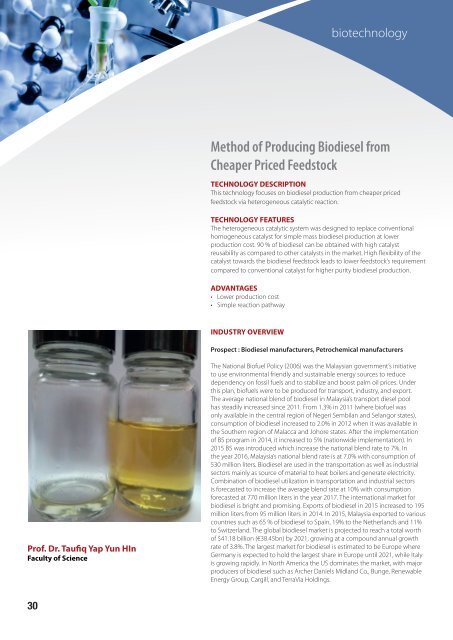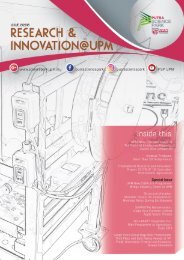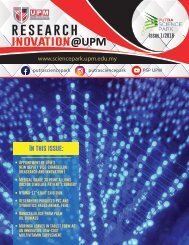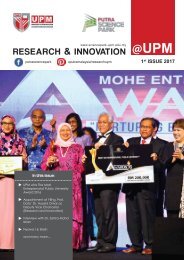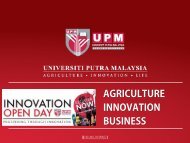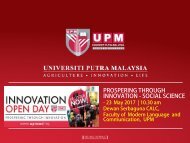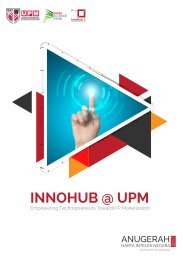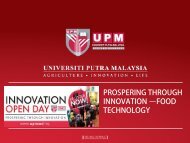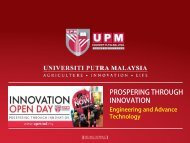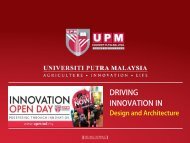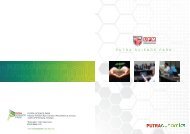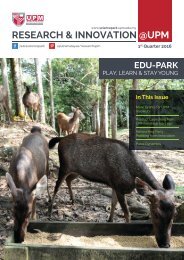Innovation directory 4th edition
You also want an ePaper? Increase the reach of your titles
YUMPU automatically turns print PDFs into web optimized ePapers that Google loves.
iotechnology<br />
Method of Producing Biodiesel from<br />
Cheaper Priced Feedstock<br />
TECHNOLOGY DESCRIPTION<br />
This technology focuses on biodiesel production from cheaper priced<br />
feedstock via heterogeneous catalytic reaction.<br />
TECHNOLOGY FEATURES<br />
The heterogeneous catalytic system was designed to replace conventional<br />
homogeneous catalyst for simple mass biodiesel production at lower<br />
production cost. 90 % of biodiesel can be obtained with high catalyst<br />
reusability as compared to other catalysts in the market. High flexibility of the<br />
catalyst towards the biodiesel feedstock leads to lower feedstock’s requirement<br />
compared to conventional catalyst for higher purity biodiesel production.<br />
ADVANTAGES<br />
• Lower production cost<br />
• Simple reaction pathway<br />
INDUSTRY OVERVIEW<br />
Prospect : Biodiesel manufacturers, Petrochemical manufacturers<br />
Prof. Dr. Taufiq Yap Yun HIn<br />
Faculty of Science<br />
The National Biofuel Policy (2006) was the Malaysian government’s initiative<br />
to use environmental friendly and sustainable energy sources to reduce<br />
dependency on fossil fuels and to stabilize and boost palm oil prices. Under<br />
this plan, biofuels were to be produced for transport, industry, and export.<br />
The average national blend of biodiesel in Malaysia’s transport diesel pool<br />
has steadily increased since 2011. From 1.3% in 2011 (where biofuel was<br />
only available in the central region of Negeri Sembilan and Selangor states),<br />
consumption of biodiesel increased to 2.0% in 2012 when it was available in<br />
the Southern region of Malacca and Johore states. After the implementation<br />
of B5 program in 2014, it increased to 5% (nationwide implementation). In<br />
2015 B5 was introduced which increase the national blend rate to 7%. In<br />
the year 2016, Malaysia’s national blend rate is at 7.0% with consumption of<br />
530 million liters. Biodiesel are used in the transportation as well as industrial<br />
sectors mainly as source of material to heat boilers and generate electricity.<br />
Combination of biodiesel utilization in transportation and industrial sectors<br />
is forecasted to increase the average blend rate at 10% with consumption<br />
forecasted at 770 million liters in the year 2017. The international market for<br />
biodiesel is bright and promising. Exports of biodiesel in 2015 increased to 195<br />
million liters from 95 million liters in 2014. In 2015, Malaysia exported to various<br />
countries such as 65 % of biodiesel to Spain, 19% to the Netherlands and 11%<br />
to Switzerland. The global biodiesel market is projected to reach a total worth<br />
of $41.18 billion (€38.45bn) by 2021, growing at a compound annual growth<br />
rate of 3.8%. The largest market for biodiesel is estimated to be Europe where<br />
Germany is expected to hold the largest share in Europe until 2021, while Italy<br />
is growing rapidly. In North America the US dominates the market, with major<br />
producers of biodiesel such as Archer Daniels Midland Co., Bunge, Renewable<br />
Energy Group, Cargill, and TerraVia Holdings.<br />
30


